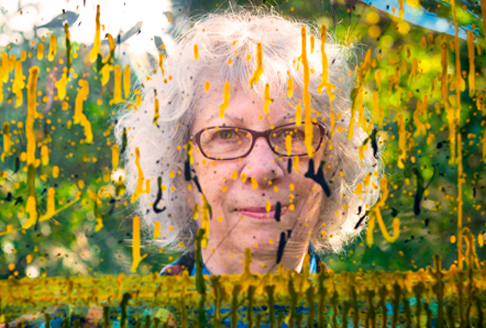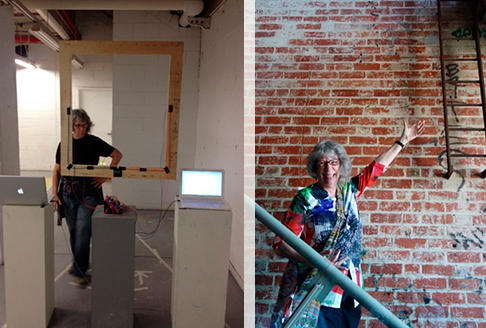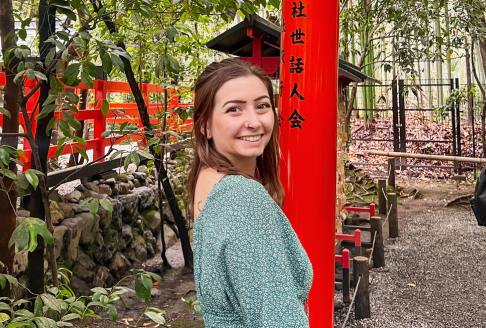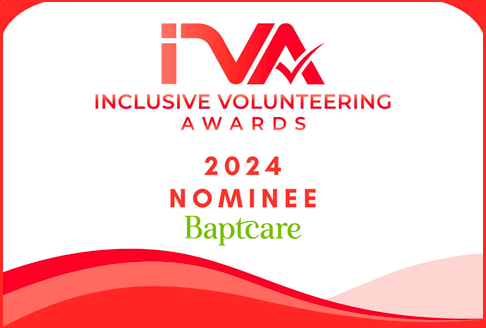Faces of Baptcare #49 | Meet Carol Gardner
We say it often and we mean it always: our Baptcare community – staff and customers – is endlessly dynamic and fascinating. Our Faces of Baptcare series enjoys showcasing these vibrant individuals, such as Home Care client Carol Gardner.
It is such a privilege for Baptcare to work alongside our community to ensure that our clients can live a full life on their own terms. In the case of our home care services, this can mean that clients such as Carol are able to stay home and continue to do what they love; in the case of Carol, to devote her energies to her artistic endeavours.
If you look up Carol Gardner’s profile you’ll see the following:
Job title: Sculptor, explorer, artist.
About Me: My life has been peripatetic, and this has created in me a profound curiosity for, and interest in, most things, but in particular the stories associated with things, their narrative, their history, and those characteristics that are common to all locations and things, namely colour, texture, and materiality.
Carol’s art is described as an experimental spatial practice which includes sculpture, public art, performance, video, mixed media and installation.
She has exhibited internationally, curated exhibitions, managed touring exhibitions, delivered lectures and guided school children through Heide Museum of Modern Art.
She has also added to her formal education (BSc in Maths and IT, Diploma in Management Studies) by completing a BA (Fine Art) in Sculpture, Sound & Spatial Practice, with Distinction, at RMIT.

Carol, let’s start with some questions about you and your art. When did you start your artistic life?
I started quite late really – at about 50 years of age.
I began with oil painting but I realised that if I wanted to be good at an art form at my age then I’d need to do something different because all the traditional mediums – like oil paintings – required years of practice and I was starting late in life and would therefore need to spend my time mastering the technique rather than being creative.
I also realised that I wanted to explore and experiment, to try and do something that hasn’t been done before.
How would you describe your art now?
Sculpture in a broad sense. It’s spatial, three-dimensional work. I also dabble in the more conventional mediums like drawing and painting, but I tend to subvert them. For example, if I’m drawing, I’ll use my non-dominant hand – i.e. my left hand – so that what I draw isn’t good by definition but I hope will be more interesting and more creative. I’m really into left-handed drawing now!
Can I ask what drew you into these forms of art?
I’m always driven by curiosity – why and how things are – including their stories and characteristics of behaviour, colour, texture, materiality, sound and smell.
Who are your favourite artists?
My first artist would be Robert Rauschenberg, a 1950s New York artist. I studied him when I lived in the UK and his art sang to me. He was remembered for moving the depiction of an object or idea from the vertical plane (i.e. a painting hanging on a wall) to the horizontal plane (i.e. the floor). Instead of having to paint the illusion of three-dimensional space, he used the real space.
Others include: Lorna Crane, an experimental textile artist and teacher (I did an online course with her during Covid – she saved my life!); Robbie Rolands, one of my teachers at RMIT who does amazing spatial work; and Laura Woodward, another one of my teachers at RMIT who marries science and art – that’s what attracted me to her.
I’m fascinated by your professional Maths/IT/corporate background and your journey into fine arts.
My Science degree majored in various forms of Maths, including computer science. I was introduced to programming in 1971 and worked on a huge computer ‘machine’ before there were any desktop computers in the world. From university, I worked in the Information Technology business within the SECWA (WA State Energy Commission), and the Radiophysics Division of CSIRO, working with big radio telescope dishes that pick up noise from space. It was wonderful work! I was there as a young assistant who was just beginning to learn about programming.
Were there many women in that workforce?
No, mainly men. There was only one woman who specialised in radio transmission from the sun and sunspots. At CSIRO they were mature and intelligent men, all with PhDs. They were kind and supportive to me as a 20-year-old girl and had a big influence on my life. I also worked in earthquake analysis, studying the effects on high rise buildings. It was a really stimulating environment.
I’m wondering how you moved from this very ‘left-brained’ world to the more creative world of art creation?
Yes, it may seem that art and IT programming are polar opposites but actually programming is very creative! I was writing computer systems that involved creative communication to work out what people wanted and then problem-solving to implement these needs efficiently. There came a time when my brain said this is all fine but let’s give some attention to my artistic side!
So what happened next?
While living in the UK in my late 30s, I started doing evening courses in drawing and oil painting while still working as a technical author.
One of the people in the course mentioned a Foundation course in art designed for people who hadn’t studied art in high school. It was two years part- time and it was amazing. I studied 16 subjects and was exposed to all art forms – photography/working with clay/drawing/painting/ sculpture/film work. When I moved back from the UK to Australia, I transferred to the RMIT BA (Fine Art) in Sculpture, Sound & Spatial Practice.
Where would you like to go with your art next?
I like the idea of teaching but I’m not a trained teacher. Also, unfortunately, my energy levels are not that great – I’ve got a heart condition – so I can’t really take on a teaching course. I’ll just give informal help where needed and keep developing my own art practice.
At this stage, my motivation is my own imagination and I like exploring and experimenting. I just want to get my creativity out – whatever it is. This isn’t always enjoyable. I had artist’s block recently triggered by arthritis in my wrists and I really had to ask myself what art I could do that wouldn’t cause me pain.
I began playing with fabrics and inks and have discovered that the way forward is to use the sewing machine in an artistic way, as I can’t hand sew because of my arthritis.
 Pictured above - Carol in action!
Pictured above - Carol in action!
Can you tell us a bit about the Banyule Open Studios Weekend?
Banyule Open Studios (BOS) was started in 2022 by a group of artists mentored by the Arts and Culture Officer at Banyule Council, Nikki Ralston, and led by my artist friend, Felicity Gordon. I’m currently the Vice President.
The Banyule Open Studios weekend is where local Banyule artists open up their studios to members of the public for two days. People should be able to see a few studios in a day. This year it’s on 14-15 October.
There is a website (https://banyuleopenstudios.com.au) containing a map showing studio locations, information about each artist and examples of their work.
And now for a few personal questions! Can you tell us something surprising about yourself?
As a child, I wanted to be an eccentric scientist. I had a picture in my head of an Einstein-looking scientist with white hair going in all directions surrounded by books and papers and thought ‘that’s what I want to be.’ Then along came Tom Baker in Dr Who and I realised that what I really wanted was to be a combination of the two!
I’m an explorer and a romantic, really.
Do you have a favourite saying/motto?
I’ve got several! I actually like to collect them. I have various quotes that I fall back on. Here’s a short saying that I learnt from a good friend:
It is as it is
not as it should be
not as you want it to be
It is as it is
I find this saying particularly relevant at my stage of life where life can be a bit of a balancing act of acknowledging things going wrong with your body and wishing it was otherwise.
I also like this saying by Vivian Green:
Life isn’t about waiting for the storm to pass
It’s about learning to dance in the rain
Now for some questions about your relationship with Baptcare and its home care support
How long have you been getting Baptcare home care?
Only a few months.
Why did you feel it was time to get home care?
My husband Peter and I have arthritis in our hands that makes certain practical tasks challenging. My husband is actually a pianist, but he has an additional condition, Dupuytren’s Contracture (a thickening of tissues in the palm of a hand).
What tasks are being supported by Baptcare’s Home Care?
We are getting domestic assistance at this stage including house-cleaning and some gardening assistance.
What kind of difference has Home Care made to your life?
We were both getting depressed and stressed by our situation. I’m 74 and my husband is 75 and we are at the age where we need to ask ourselves whether we are capable of staying in the family home or whether we should move into a smaller apartment. But we love our garden – it’s only a medium-sized garden but it does take some work.
When we bought our house ten years ago, we envisaged staying here for the foreseeable future. But recently, due to our physical challenges, we realized that we couldn’t keep up with the cleaning and maintenance alone. It was a very stressful time where we realized that we may have to move. Apart from the emotional part of that, there are practical challenges to moving. Peter has a grand piano that may not fit in another place and may annoy neighbours.
How have you found Baptcare’s Home Care services?
We are happy with our service so far but have only had a few visits accessing the house cleaning assistance. Shari (Scholes-Miller) was my main Baptcare contact, and she was just lovely – supportive and kind and explained everything very well.
Thank you for the wonderful chat, Carol. We hope you continue to enjoy Baptcare’s Home Care, keep creating and – to borrow a line from your favourite poem – that you keep ‘dancing in the rain'!
You can read more about Carol on her website
https://carolkirkwoodgardner.com/
and Instagram carol.k.gardner
You can learn more about the upcoming Banyule Open Studios weekend here:
https://banyuleopenstudios.com.au/
@banyuleopenstudios on Instagram
Banyule Open Studios on Facebook
You can also read more about home care at Baptcare at https://www.baptcare.org.au/services/home-care/what-you-need-to-know


